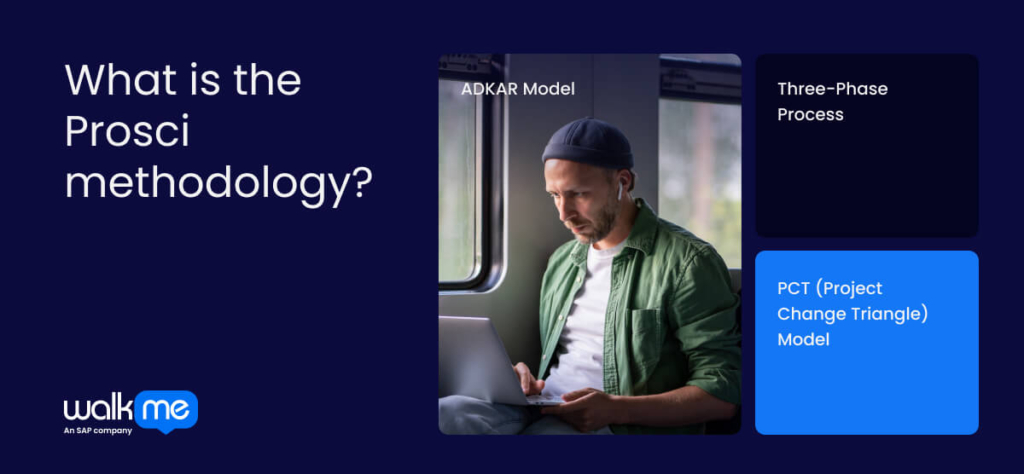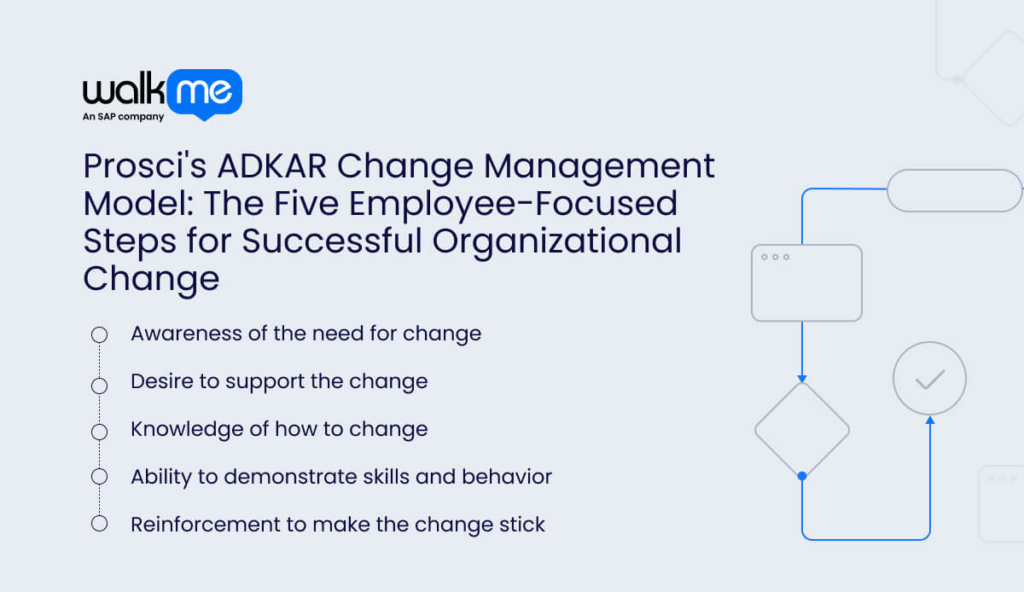Prosci change management services encompass all aspects of organizational change.
Businesses investing in change projects rely on Prosci for research-based consultancy, training, licensing, and eLearning.
However, Prosci is best known for its three trademarked change models: PCT, the 3-phase process, and, most famously, ADKAR. These models offer a comprehensive framework for managing organizational change, providing structured approaches to guide companies through complex transitions.
This article provides an overview of Prosci change management…
What is Prosci change management?
Prosci Change Management is a research-based methodology for managing people and processes during organizational change.
The framework offers practical tools and best practices to help organizations plan, implement, and sustain successful organizational changes.
It helps leaders understand how to mitigate any change resistance they may face while transitioning to new systems or processes and ensures the change is adopted long-term.
The name “Prosci” is derived from the company that developed the methods. It is a contraction of “professional” and “Science.”
Prosci was founded in 1994 by Jeff Hiatt. After extensively researching best practices for managing successful organizational change initiatives, Hiatt developed the Prosci Change Management Methodology.
With over 20 years of experience and more than three million practitioners worldwide, Prosci is recognized as a leading authority on organizational change.
Why is Prosci change management important?
Prosci change management is crucial for organizations navigating complex transitions.
It offers a structured, research-based approach to guide companies through change, focusing on both human and organizational aspects. The methodology helps leaders anticipate and address resistance, ensuring smoother adoption of new processes or technologies.
By emphasizing employee engagement from the outset, Prosci methods increase the likelihood of successful change implementation.
The ADKAR model, in particular, provides a clear framework for individual change, essential for overall organizational transformation.
Prosci’s comprehensive tools and training programs equip change managers with practical skills to lead initiatives effectively.
Its data-driven approach allows organizations to measure progress and adjust strategies as needed.
What is the Prosci methodology?

The Prosci methodology is a comprehensive, research-based approach to change management that focuses on the people side of change.
It combines three key components:
ADKAR Model
This individual change framework guides people through five stages: awareness of the need for change, desire to participate and support the change, knowledge of how to change, ability to implement required skills and behaviors, and reinforcement to sustain the change.
Three-Phase Process
This organizational change management approach includes three phases: preparing for change, managing change, and reinforcing change. Each phase contains specific activities and tools to support the change process.
PCT (Project Change Triangle) Model
This model emphasizes the importance of three key elements working together for successful change initiatives: leadership/sponsorship, project management, and change management. The PCT Model helps organizations understand the interplay between these critical factors in driving successful change.
These three elements form the core of Prosci’s structured approach to managing organizational change effectively, providing a holistic framework that addresses both individual and organizational aspects of change.
This methodology is widely used across various industries and is known for its practical, adaptable approach to managing organizational change.
What is the Prosci model?
The most prominent part of the Prosci methodology is the ADKAR model.
The ADKAR change management model has been under development since 1998 and is used by some of the world’s largest companies. Prosci training sessions focus on inculcating and applying the ADKAR model.

The acronym ADKAR describes the five stages of Prosci’s change management system. They stand for the following concepts:
Awareness of the need for change
This step focuses on raising an understanding of why a change must happen. By identifying the drivers for change, change leaders ensure employees understand why the change is necessary. This awareness should be communicated throughout the organization, from top-level executives to frontline staff. Stakeholders should be made aware of the potential consequences of not making the change and the benefits that will come with it.
Desire to support the change
The second step motivates employees to participate in the change. It helps people engage with the change and understand why it should be embraced. Change leaders communicate how this change brings value and how it will positively impact the work of every employee in the organization. Leaders will also empower employees to take ownership of the initiative.
Knowledge of how to change
This stage focuses on how employees can make the change happen. Staff must be taught how to execute the change effectively. To achieve this goal, the change management team will organize an appropriate rollout of staff training. Staff will learn about the new tools they will need to use and any new skills they need to know along the way.
Ability to demonstrate skills and behavior
In this stage, staff discover how to apply their knowledge to real-life working situations. They may do this through on-the-job training, coaching, or shadowing opportunities for staff. In an environment of support and collaboration, employees learn to adapt their working style to the new processes and systems.
Reinforcement to make the change stick
Reinforcement ensures that the change is sustained and embedded into the organization. To do this, leaders should monitor progress, provide regular feedback on performance, identify any issues or challenges faced by staff, and recognize positive contributions made by individuals toward a successful adoption. Performance metrics can also evaluate change initiatives and ensure the change is accepted long-term.
What are Prosci’s “three states” of change?
Prosci’s “Three States of Change” framework provides a structured approach to understanding and implementing organizational change.
This model helps clarify the complex change management process, identifying key steps for successful implementation.
Breaking down the change process into distinct phases, organizations can better navigate the challenges and opportunities that arise during transformational initiatives.
The “three states” of change are:
The current state
The current state represents the organization’s present situation. At this stage, leadership must critically examine existing work systems to identify areas for improvement.
While many employees may be comfortable with the status quo, change management professionals must find ways to demonstrate the potential benefits of change for all stakeholders.
The transition state
The transition state is often uncomfortable and may be considered a necessary evil. This phase involves moving away from familiar routines, which can feel challenging and unfamiliar.
Change resistance typically peaks during this stage, with many staff members reluctant to embrace new demands in their work lives. Leaders must maintain a clear vision to guide the organization through this difficult period and ensure positive outcomes for all participants.
The future state
The future state can be difficult to envision at the outset of a change initiative. However, organizations typically aim to leverage a combination of ideas, attitudes, and vision to drive successful change and ensure ongoing success.
This state represents the ultimate goal of the change process and the desired outcome of the transformation efforts.
What is a Prosci certification?
Prosci certification is a widely recognized professional credential in the field of change management.
These certifications validate an individual’s expertise in applying Prosci’s research-based methodologies to drive successful organizational change.
Prosci offers three main types of certifications, each designed for different levels of experience and career focus within change management.
Let’s take a closer look:
Prosci Certified Change Practitioner (PCCP)
This is the foundational certification for change management professionals. It involves a three-day immersive learning experience, during which participants apply Prosci’s methodology and tools hands-on.
To earn the certification, individuals must pass an exam demonstrating their proficiency. Upon certification, practitioners access Prosci’s extensive change management resources, enabling them to apply these tools and techniques.
Prosci Advanced Change Practitioner
Designed for experienced change managers, this certification builds upon the PCCP and requires prior program completion.
The Advanced Change Practitioner certification focuses on more complex change management strategies and involves a more intensive training program. It emphasizes the strategic application of change management principles, preparing professionals to handle large-scale and complex organizational changes.
Prosci Advanced Instructor
This top-tier certification is tailored for those who wish to teach Prosci methodologies to others. It requires extensive change management experience and rigorous training in Prosci’s teaching methods. Advanced Instructors are enabled to deliver Prosci certification programs and gain access to Prosci’s instructor-level resources and community.
This certification is ideal for those looking to take on leadership in spreading change management best practices within their organization or as independent consultants.
Why use Prosci change management?
Prosci’s methods offer a robust framework for large companies developing a change management plan.
The methodology’s popularity has made it nearly an industry standard, backed by a comprehensive certification program and research-based approach. Prosci provides a coherent and practical strategy for managing organizational change.
However, it’s important to note that Prosci methods aren’t a guaranteed recipe for success.
While the ADKAR model is valuable, it’s not sufficient alone to ensure successful change. It comes into play only after change goals are set, potentially missing crucial early-stage considerations. Additionally, the methodology may not fully account for unique organizational structures, and the certification process can be expensive.
Prosci methods serve as an excellent starting point for change management. They offer valuable tools and frameworks, but the experience and wisdom of seasoned change leaders should complement them.
The most effective approach often combines Prosci’s structured methodology with tailored strategies that address an organization’s specific needs and challenges.
Embracing the Prosci approach to change management
While many change management models exist, including McKinsey’s 7 S, the Lippitt-Knoster model, and Kotter’s 8-step method, Prosci has emerged as a leading force in change management and leadership.
Their research-based approach, focusing on the people side of change, has gained significant traction among organizations worldwide. Prosci’s methodology offers a structured process, integrates with project management, and provides customizable tools and resources.
Their widely recognized certification programs have further solidified their authority in the field. However, it’s important to note that Prosci’s approach, while highly regarded, is not the only effective framework for managing change.
Many other methodologies and techniques exist, some with long-standing histories. Effective change practitioners may draw from multiple approaches, adapting them to specific organizational needs.
Ultimately, successful change management relies on applying the right tools and techniques, whether from Prosci or other reputable sources.
FAQs
Prosci identifies 10 aspects of change that may be impacted during organizational transitions:
- Processes
- Systems
- Tools
- Job roles
- Critical behaviors
- Mindsets/attitudes/beliefs
- Reporting structure
- Performance reviews
- Compensation
- Location
The Prosci approach is a research-based change management methodology. It emphasizes the people side of change, integrating individual change management (ADKAR model) with organizational change management processes.
Prosci provides tools, training, and certifications to help organizations implement successful change initiatives.

